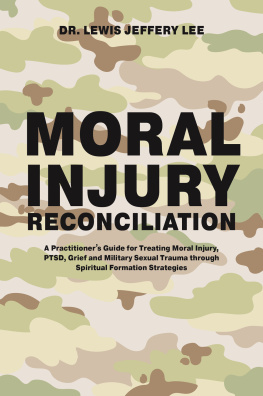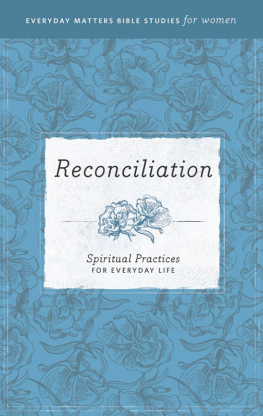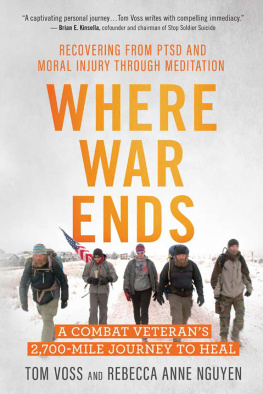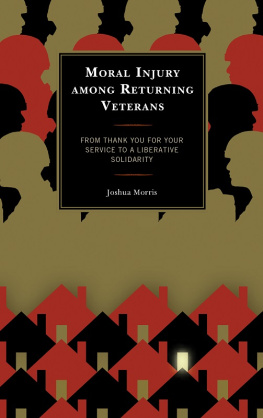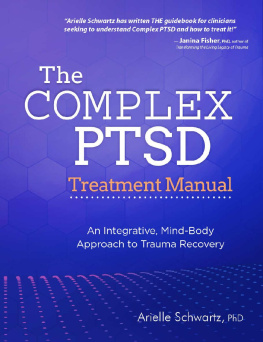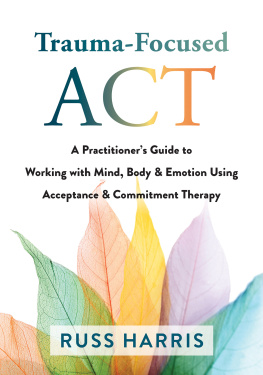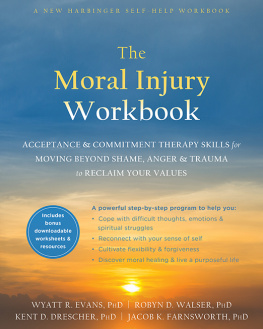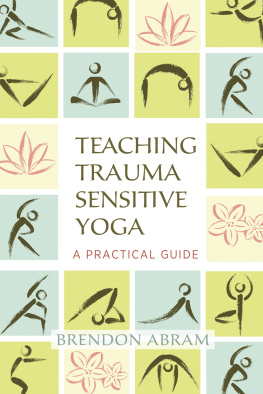
MORAL INJURY
RECONCILIATION
A Practitioners Guide for Treating Moral Injury,
PTSD, Grief, and Military Sexual Trauma
through Spiritual Formation Strategies
LEWIS JEFF LEE

Jessica Kingsley Publishers
London and Philadelphia
Contents
Preface
Foundations are the bedrock of excellence. For out of the basics , great deeds result. This adage seems truer now than ever. Football great Vince Lombardi of the Green Bay Packers appeared to embody this belief. Not only famous for Super Bowl championship wins, but for opening pre-season training camp with hard-nosed men of the gridiron saying: Gentlemen, this is a football. When my old boss from SEAL Team THREE Bill McCraven wrote the book titled Make Your Bed (2017), I was reminded of this principle. This rule finds that basic habits are the keys to profound change. Both men underscore the ideals found in this treatment guide. The basics set the stage for reversing difficulties with habits that increase endurance. Making such a rule actionable will transform ones head, heart, and life.
Investing in others is a basic principle I learned. I also learned that hard work and looking out for your neighbor were commendable moral standards. Investing in another is a sorely needed remedy amidst the overheated political climate and the one-upmanship that prevails. Concern for a fellow citizen is a character-shaping virtue that transforms the benefactor and uplifts the beneficiary.
Early on, I sensed life was about more than things or positions. And as I survey my life, it is characterized by service and wider community-building efforts. At a young age I partnered with the Muscular Dystrophy Association, then the American Red Cross, and other volunteer groups that provided initial opportunities to serve. I took advantage of those openings and worked for the good of others. My active-duty service further suggests my lifelong quest to serve. To be sure, I find high honor and great reward in giving to a worthy cause such as righting wrongs, and protecting the young, helpless, and disadvantaged. This is my calling.
The moral injury reconciliation approach (also known as the reconciliation model ) continues in a service-oriented direction. The strength of this methodology is believed found in its three-phased thematic, religious/spiritual framework. Its design aims to bind the spiritual and psychic wounds of the past and promote new thinking that affects present functioning and ones future outlook. To be sure, while some scars will remain, new strategies and the continued support of those in and out of uniform are critically needed. My incentive to help wounded men and women recover is borne out of gratitude and a want for the good of others. The moral injury reconciliation model is the result of personal experience in the helping professions, military service, and decades of religious/spiritual study.
However, before caring for those challenged by moral injury or posttraumatic stress, mental health providers are encouraged to gain a keen knowledge of the military landscape. An understanding of the makeup of veterans, servicemembers, and their families is an essential competency. It will weigh heavily as part of the formula for achieving positive outcomes. It is also part of the basics of this proposed treatment.
Moral injury presents when ones moralethical codes have been violated. Once violated, the moral injury spectrum of guilt, shame, isolation, psychic numbing, or depression steers a course toward maladaptive behaviors known as invisible wounds . Yet despite such an injury, the reconciliation model offers hope.
In the past, I aided the visibly handicapped. Now, I am determined to treat the inside wounds; the wounds that cripple the spiritual and emotional health of our veterans and military personnel. Without a therapeutic spirit of service, ultimately, a clients symptoms may go unattended. Hopelessness and grave physical consequences may result. Investing in others may be viewed as an investment where the caregiver joins in the spiritual transformation of the afflicted. Both patient and provider are changed.
Following is one mans progressive immersion into the unique culture of military life and the plan to continue serving the morally wounded. This plan is a spiritual care strategy for full life transformation that addresses recovery from moral injury and other trauma. This strategy is founded on religious/spiritual, psychological, and physical remedies both ancient and new. As you read, I encourage you to use my life story as a pretext for understanding the influences that shaped other veterans and active-duty personnel. While each person is unique, a common thread may be found in the life stories of those who have served or currently serving. For the military experience must be understood as a cultural transformation where the potential for moral injury uniquely exists. Mine is such a story.
My transformation started over 50 years ago. When I was aged about seven, my brothers and I discovered my fathers drab World War II olive U.S. Army blouse respectfully folded and neatly stowed. With great deference, we would cautiously sneak a peek at this exhibit. It was complete with stripes, patches, and insignia tucked discreetly in my parents bottom dresser drawer. Although I could not explain it, I was transfixed, however briefly, by this icon from American history of which my father was a part. As I held, smelled, and fingered the texture of the garment, I imagined this uniform somehow representing a greater good. A noble cause. It was proof of service to others. As I later realized, it was proof, too, that the military was governed by discipline, order, meaning, and higher ideals. His uniform stood for something.
Other life events steadily sparked my continued interest in military life. Together, they increasingly infused a passion to serve. One such influence was church attendance; the other was television.
We went to church often as a family. And, like many children, I was ambivalent about church matters and rambunctious. I had trouble sitting still as older women taught childrens Bible lessons with flannel board figures as visual aids. On a typical church day, the transition between the childrens church and the main service was punctuated by unauthorized excursions. My brothers and I would sneak out the side door, cross the street, and buy candy with our church offering. Then, we would slip back inside and find our seats before the main service started. But little did I realize the impact the religious/spiritual teachings were having. It was there I understood my calling. Later, I realized the many religious precepts had strong associations with the moral principles forming the bedrock of warrior codes as well as the foundation of many secular civil laws. At this age, an uncanny resonance between religious/spiritual doctrines and the fabric of life emerged.
Next, television notably impacted me. Television brought historic and vivid images to life. I laughed at The Three Stooges , enjoyed the black and white cartoons, and watched other variety programming like The Ed Sullivan Show . But I took a different sort of interest in the news coverage presented. For instance, networks like ABC and CBS were reporting distant accounts of current events of the 1960s. And as my father switched between the NBC Nightly News or the HuntleyBrinkley Report , I found myself standing, watching intently as news coverage inspired a special level of awareness. News programming routinely featured American KIAs (killed in action) or the major campaigns of the escalating Vietnam conflict. While I could not fully grasp the import of the national geopolitical strategy of the time, I again felt such reporting was highly significant. I wanted to do something to help.
Next page
